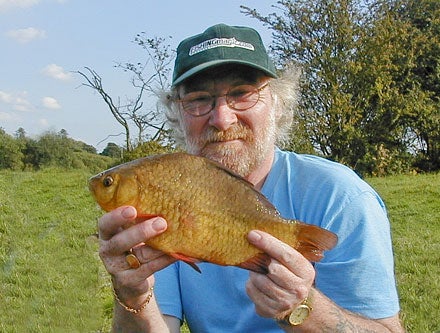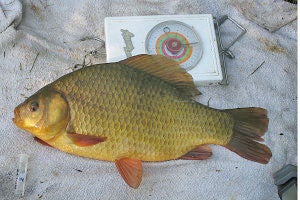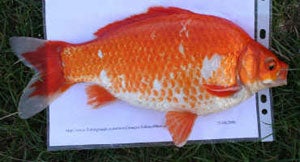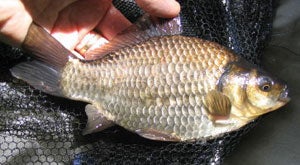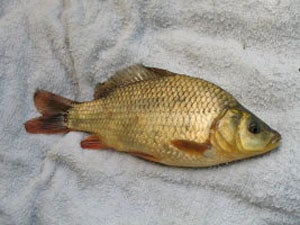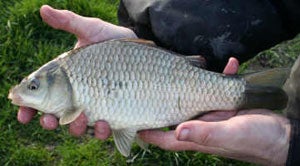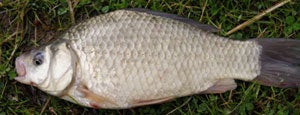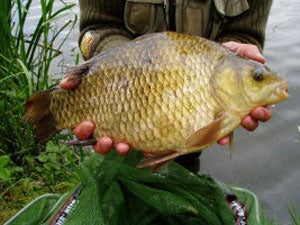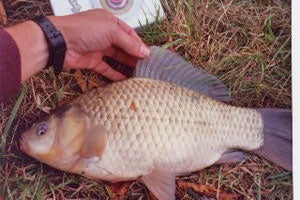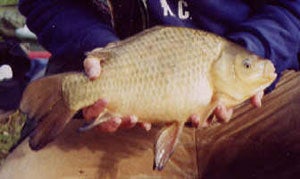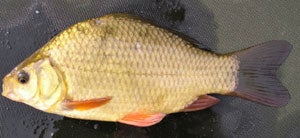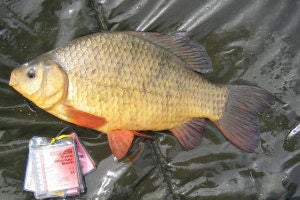Crucians, Carp, Brown Goldfish and Crucian HybridsI wrote recently about the variable shape of true Crucian Carp. Now I’ll try to describe the differences as I see them between that species and the other Crucian look-alikes that swim in UK waters. When I come to deal with hybrids, I’ll have to limit my remarks to first crosses, ie hybrids between the species (Crucian, Goldfish and Carp). There’s no doubt that second-crosses exist but no-one really knows how common they are in the wild and I don’t think anyone at this stage can identify them with any certainty.
First, I’ll describe two of the three species involved. I have assumed that we can all recognise the third species, Carp, whether it be Common Carp, Mirror Carp or Leather Carp, French, Italian or German, Leney or Simmonds, Wild or King. However, not everyone has had enough experience to tell the difference between Crucian Carp and Brown Goldfish, so I thought it would be a good idea to sum up what these two look like before going on to describe the common hybrids. Identifying Crucian Carp (Carassius carassius) The fish in your net is likely to be a true Crucian if the following apply:
If you have the chance to cut up a Crucian, perhaps a rejected heron victim, you will find that:
If you’re lucky, the fish in your net will look like this 1lb 10oz beauty, a genetically tested true crucian, though not of the high-backed shape we’re all familiar with from press photographs of record or near-record fish.
* The lateral line scale count has been confusing people for a long time. In the early twentieth century a count of 28 – 35, apparently first stated by Tate Regan, was commonly used thereafter by popular writers. No-one in those days seems to have known about feral Goldfish or hybrids, so the over-wide range went uncorrected and was used without question when interest in Crucian Carp began to re-surface. Scientists like Ekstrőm, who specified 32 -34, had actually studied the fish and were aware of the differences. If you examine closely any good photograph of a true Crucian Carp the lateral line scale count will almost always be 32, 33 or 34. That doesn’t rule out 31 or 35/36 as belonging to a true Crucian but at those extremes I begin to suspect Crucian x Goldfish and Crucian x Common Carp (or Goldfish x Common Carp) respectively. So a count of 32 – 34 suggests strongly that your fish is a true Crucian, but please remember that it needs to be taken in combination with the other characteristics. For example, a goldfish x crucian hybrid can have 32 lateral line scales and a goldfish x common carp hybrid can have a scale count of, say, 34, approximately mid-way between a carp’s 35 – 39 and a goldfish’s 28 – 30. So a lateral line count on its own is not enough to identify a crucian correctly, though it is a good place to start. The ultimate test, of course, is genetic. In the case of a record fish or where it is important to keep the Crucian Carp strain pure, it must be worth investing in a simple DNA test. The EA should be your first port of call for information on this. Identifying the Brown Goldfish (Carassius auratus) We’d all recognise this fish if it turned up in our landing net:
But if the fish were brown instead of red, gold and white you might think you’d caught a Crucian Carp. In practice, once you’ve handled both species the differences between them quickly become clear. Until then, though, these guidelines could help:
On the first gill arch there are two sets of gill rakers, front and back, over-lapping to prevent prey escaping. The front set in the Goldfish contains 38 – 43. Below, is a typical brown Goldfish:
Identifying Crucian (and Goldfish) Hybrids (Now comes the more difficult bit, the hybrids. Please remember that I’m going to deal only with crosses between species, not F2s and back-crosses. I believe it has become convention to put the female parent first and the male second. So Goldfish x Crucian = female Goldfish x male Crucian. I’ve ignored this in my descriptions, because I just don’t know, so the order I’ve put them in is not significant. Crucian Carp cross-breed (a) with Common/Mirror/Leather Carp and (b) with Goldfish, to which they are very closely related. (a) Crucian x Carp (Carassius carassius x Cyprinus carpio) has been known about since the beginning of the nineteenth century. Once upon a time it was known as “the bastard carp”, Carpio kolarii. In the wild it exists but is not all that common, largely because the two species spawn at slightly different times: in our ponds here the Common Carp seems to need a higher water temperature than the Crucian Carp and spawns about a fortnight later. I’ve looked after ponds with both Carp and Crucians in for many years, and almost always, even in field ponds as small as 30m in diameter, the two species have kept themselves to themselves. However, spawnings can overlap (a) where the fish have to share a very limited number of spawning sites, or (b) in a year when water temperatures rise very quickly in the spring as in 2006, or (c) when cold conditions last longer than usual and all spawnings are delayed. A year or two later, you begin to catch fish that somehow don’t look like quite either species, like this one, example 1.
(This came from a pond where there are only Carp and Crucians but Goldfish too can cross-breed with Carp. It is very difficult to tell the two hybrids apart, even in the laboratory.) As a rule of thumb, hybrids may look a bit like either parent, depending on the genetic mix, but many of the fish’s features are intermediate. So, in the one above, the dorsal fin is convex-ish, like a Crucian’s, but much lower – like a Carp. There is a steep rise behind the head, like a Crucian, but the head itself is quite long, with the eye set far back, like a Carp. The lateral line count in this case is 36, intermediate between a 34 Crucian and a 38 Carp. The colour overall is an slight gold, but lacks the distinctive contrasting brassiness on the gill covers and front belly/flank of your average Crucian. The paired fins are nearly Crucian – coloured. What clinches the identification for me is the fact that the barbules are tiny, far too small to be detected on the photograph, though definitely there. A Crucian has none; in a Common Carp they are large and obvious. Example 2, below, has only 34 scales along the lateral line, at first sight a Crucian count. Common carp have 35 – 39. Goldfish have 28 – 30, though, and this looks to be a Goldfish x Common Carp. In fact the light-coloured pectoral and pelvic fins give another clue that this is so. Even scientists under laboratory conditions find it difficult to tell the two hybrids apart and given the fact that not everyone in the fish business can tell a crucian from a brown goldfish even, it wouldn’t be very surprising to find that many of the “F1s” out there are not Crucian x Carp at all but are in fact Goldfish x Carp. Not that it matters very much: both cross-spawnings presumably result in the sort of hybrid that some match fishery owners want. In fact, in the case of this example there is more danger of calling it a Carp than a Crucian or Goldfish, neither of which it looks much like. Its almost non-existent barbules, though, and the short lateral line, confirm its mixed ancestry.
As you know, the crucian x carp has been produced on a commercial scale and marketed as “F1s”. I read that a number of commercial waters now contain them, their attraction being that they don’t grow too big for match fishermen. Also, they are extremely hardy and apparently can be persuaded to feed all the year round. I have no experience of mass stockings of this fish, but some of you reading this will have done so. Do they all have barbules, as the books say they have? – remember that sometimes they are very difficult to detect. My local commercial water owner says that the fish that dominate one of his match waters are F1s, but they are in fact Crucian x Goldfish hybrids – at least, the ones I’ve caught are – so it is quite easy to confuse the two. Please see below! (b) Crucian Carp x Goldfish (Carassius carassius x Carassius auratus) are the hybrids that cause most confusion. Where the hybrid favours the Goldfish parent in appearance, there’s not too much of a problem, as in this one :
Following the rule of thumb that hybrid characteristics are intermediate to the parent species, this fish’s 31 lateral line scales indicate a Crucian Carp x Goldfish hybrid. Its body and fins are drab in colour. The paleness of the lower fins, in particular, suggest its Goldfish connection. There are no barbules. But what about this one, a super, deep fish?
We could be forgiven for thinking that this is a near-record Crucian Carp, at something over 4lbs. There are no barbules and the colour of the dorsal and caudal fins doesn’t look far wrong. The body, too, has a gold sheen that suggests Crucian carp. However, the pectorals and pelvics are pale, a characteristic of Brown Goldfish rather than of Crucians, and although there is a Crucian-like interruption in the slotting of the lateral line scales there are only 30 of them. So I reckon that this, too, is a Crucian X Goldfish. And here’s another mongrel, this one looking more like a Brown Goldfish, with characteristically pale under-fins, but with the slightly longer lateral line and the rather ambiguous dorsal fin of the hybrid, suggesting Crucian influence.
And lastly, here’s a Swedish example of a Goldfish x Crucian Carp hybrid. Though the picture isn’t very good, you can just make out 30 or 31 lateral line scales and see the pale under-fins, particularly the pectorals. The pelvics ask a question, too.
And just to remind you what a true Crucian Carp looks like, here are two more, of different strains, both smallish fish and DNA verified:
To repeat some of the main points of the article, then:
(the denticulations on the anal and dorsal spines are intermediate in size, which is really not much help! I put this in merely to suggest that anoraks could try counting these denticulations, easy enough under a good hand lens. We could perhaps begin to draw some conclusions from this if we had enough data.) What I’ve written should enable us to recognise about 90% of the Crucian look-alikes we’re likely to meet. If your experiences and conclusions are different from mine, it would be useful to hear about them. If we pool knowledge, there’s a much better chance of understanding the Crucian Carp and its relatives. Finally, you’ll notice that I’ve quite often used words like “suggest”, “may” and “usually”. That’s because I’ve found that it’s dangerous to try to put nature into neat little boxes; there are nearly always exceptions! Photos b, e, f, h, j courtesy of Mark Wintle; photo g courtesy of Richard Fisk |
Welcome!Log into your account










